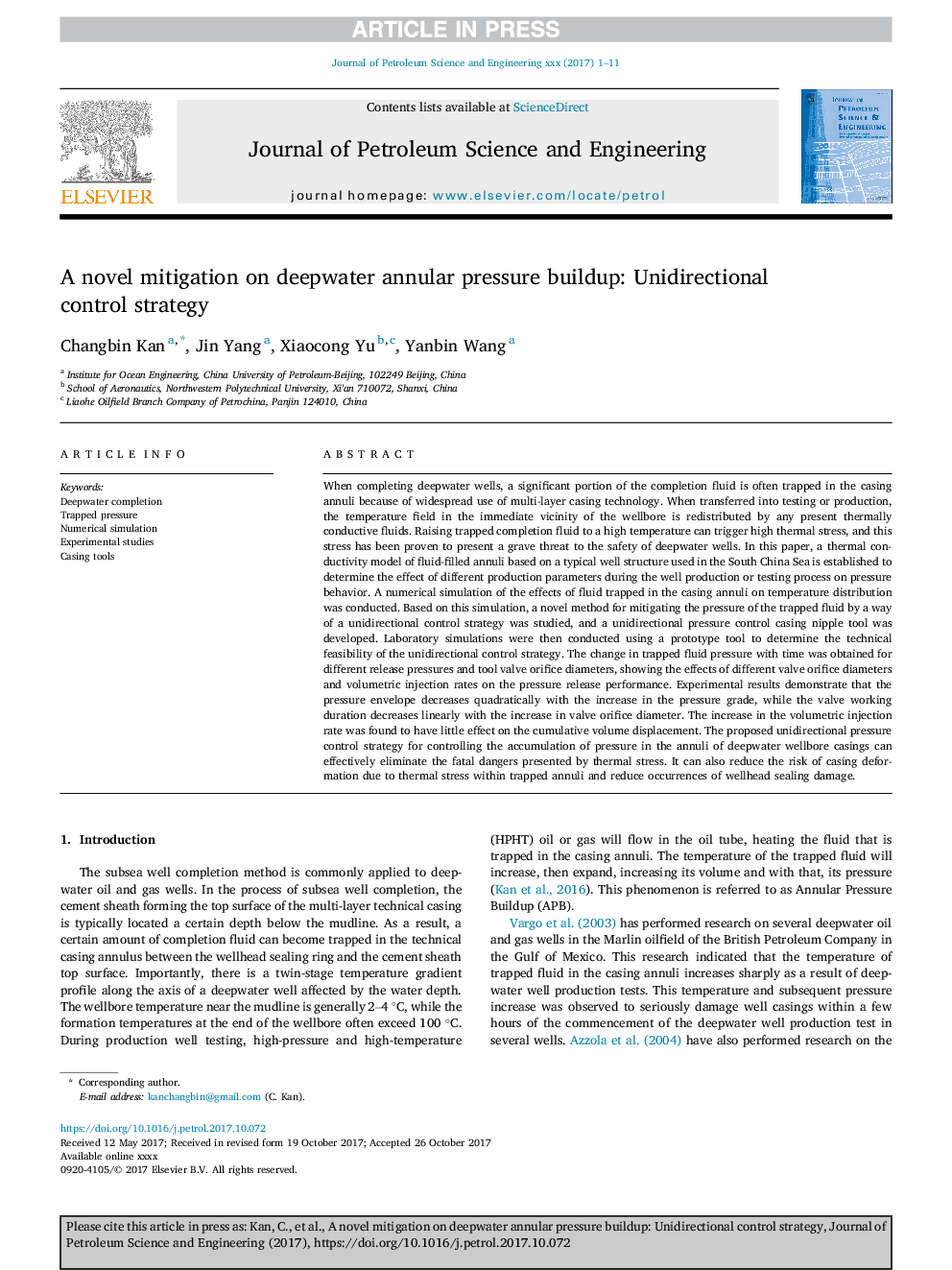| کد مقاله | کد نشریه | سال انتشار | مقاله انگلیسی | نسخه تمام متن |
|---|---|---|---|---|
| 8125506 | 1522779 | 2018 | 11 صفحه PDF | دانلود رایگان |
عنوان انگلیسی مقاله ISI
A novel mitigation on deepwater annular pressure buildup: Unidirectional control strategy
ترجمه فارسی عنوان
کاهش جدید در افزایش فشار حلقوی عمیق: استراتژی کنترل یک طرفه
دانلود مقاله + سفارش ترجمه
دانلود مقاله ISI انگلیسی
رایگان برای ایرانیان
کلمات کلیدی
تکمیل عمیق آب، فشار به دام افتاده، شبیه سازی عددی، مطالعات تجربی، ابزارهای پوششی
ترجمه چکیده
در هنگام تکمیل چاه های آب های عمیق، بخش قابل توجهی از مایع تکمیل شده به دلیل استفاده گسترده از فن آوری پوشش چند لایه، در حلقه های پوششی به دام افتاده است. هنگامی که به آزمایش یا تولید منتقل می شود، دمای دما در مجاورت چاه آب با هر نوع مایعات هدایت گرمای موجود توزیع می شود. افزایش مایع تکمیلی به دام افتاده به دمای بالا می تواند فشارهای شدید حرارتی ایجاد کند و این استرس اثبات شده است که تهدید جدی برای ایمنی چاه های عمیق آب وجود دارد. در این مقاله، یک مدل هدایت حرارتی حلقه های مایع پر شده بر اساس یک ساختار چاه معمولی که در دریای چینی مورد استفاده قرار می گیرد، برای تعیین اثر پارامترهای تولید مختلف در طول تولید یا آزمایش چاه بر رفتار فشار ایجاد می شود. یک شبیه سازی عددی از اثرات مایع به دام افتاده در حلقه پوشش بر روی توزیع دما انجام شد. بر اساس این شبیه سازی، یک روش جدید برای کاهش فشار مایع به دام افتاده با روش استراتژی کنترل دو طرفه مورد بررسی قرار گرفت و یک ابزار نوک پیک تحت کنترل فشار یک طرفه ای طراحی شد. سپس شبیه سازی آزمایشگاهی با استفاده از یک ابزار نمونه اولیه برای تعیین امکان سنجی فنی یک استراتژی کنترل یک طرفه انجام شد. تغییر در فشار مایع به دام افتاده با زمان برای فشار های مختلف آزاد سازی و قطر دیافراگم سوپاپ ابزار، نشان داد که اثرات قطر سوراخ دریچه های مختلف و میزان تزریق حجمی بر عملکرد خروجی فشار. نتایج تجربی نشان می دهد که پوشش فشار به صورت چهارگانه با افزایش درجه فشار کاهش می یابد، در حالی که طول کار شیر عملکرد خطی با افزایش قطر سوراخ دریچه کاهش می یابد. افزایش سرعت تزریق حجمی اثرات کمی بر جابجایی حجم انباشته داشت. استراتژی کنترل فشار یک طرفه برای کنترل انباشت فشار در حلقه های چاه های چاه دریای عمیق می تواند به طور موثر خطرات مرگ و میر ارائه شده توسط استرس حرارتی را از بین ببرد. همچنین می تواند خطر تغییر شکل پوشش را به دلیل استرس حرارتی درون حلقه های به دام افتاده کاهش دهد و موجب آسیب رساندن حفره های چاه شود.
موضوعات مرتبط
مهندسی و علوم پایه
علوم زمین و سیارات
زمین شناسی اقتصادی
چکیده انگلیسی
When completing deepwater wells, a significant portion of the completion fluid is often trapped in the casing annuli because of widespread use of multi-layer casing technology. When transferred into testing or production, the temperature field in the immediate vicinity of the wellbore is redistributed by any present thermally conductive fluids. Raising trapped completion fluid to a high temperature can trigger high thermal stress, and this stress has been proven to present a grave threat to the safety of deepwater wells. In this paper, a thermal conductivity model of fluid-filled annuli based on a typical well structure used in the South China Sea is established to determine the effect of different production parameters during the well production or testing process on pressure behavior. A numerical simulation of the effects of fluid trapped in the casing annuli on temperature distribution was conducted. Based on this simulation, a novel method for mitigating the pressure of the trapped fluid by a way of a unidirectional control strategy was studied, and a unidirectional pressure control casing nipple tool was developed. Laboratory simulations were then conducted using a prototype tool to determine the technical feasibility of the unidirectional control strategy. The change in trapped fluid pressure with time was obtained for different release pressures and tool valve orifice diameters, showing the effects of different valve orifice diameters and volumetric injection rates on the pressure release performance. Experimental results demonstrate that the pressure envelope decreases quadratically with the increase in the pressure grade, while the valve working duration decreases linearly with the increase in valve orifice diameter. The increase in the volumetric injection rate was found to have little effect on the cumulative volume displacement. The proposed unidirectional pressure control strategy for controlling the accumulation of pressure in the annuli of deepwater wellbore casings can effectively eliminate the fatal dangers presented by thermal stress. It can also reduce the risk of casing deformation due to thermal stress within trapped annuli and reduce occurrences of wellhead sealing damage.
ناشر
Database: Elsevier - ScienceDirect (ساینس دایرکت)
Journal: Journal of Petroleum Science and Engineering - Volume 162, March 2018, Pages 577-587
Journal: Journal of Petroleum Science and Engineering - Volume 162, March 2018, Pages 577-587
نویسندگان
Changbin Kan, Jin Yang, Xiaocong Yu, Yanbin Wang,
